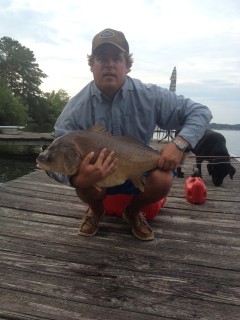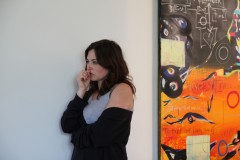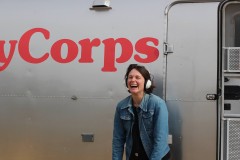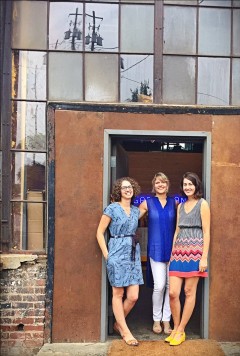Alumni Story: Documenting the South
This article by Rebecca Lauck Cleary originally appeared in the Fall 2015 Southern Register. Read the full issue and access past issues here.
Documenting the South: Southern Studies Alums Take Their Training into the Field
These Southern Studies alums are all documentarians. Whether they are producing a podcast about a beloved home region, filming lectures on the history of fishing, making films for social change, or producing content for StoryCorps, they all help explore the varied nature of the South with their investigations.
Anna Hamilton

Anna Hamilton’s Watershed podcast celebrates its one-year anniversary next month. Podcasting is a natural fit for her because she’s both a radio producer and an oral historian by trade. The medium is also a great way to experiment and to showcase stories that traditional broadcasting forms may not accommodate. Hamilton graduated with an MA in Southern Studies in 2014.
Tell me about the Watershed podcasts.
The premise is to use audio storytelling to explore how we shape Florida’s environment and how the environment shapes us. A tagline I often use is “Exploring Florida in Flux,” which is a pretty good summation. With that mission I can highlight a huge breadth of stories on the environmental topics continuum: policy, history, foodways, activism, art, and so on. We’ve told stories of potato farmers, bat biologists, longleaf pine enthusiasts, political controversy, conservation photographers, and more.
For now, this is a totally extracurricular side project. No one pays me to do it, though I occasionally receive donations from listeners. It’s not my full-time job. I would love to have the time and resources to devote more energy and attention to it, to create a business plan, and to bring in other producers and reporters to add a variety of perspectives.
Why is it important for you to explore the Florida landscape through podcasts?
Part of what I’m trying to do with Watershed is to uncover a more nuanced and complicated understanding of the state and its environment.
On a more personal level, Watershed is a response to the unprecedented growth we’re seeing in Florida. I hardly recognize where I grew up, and though that’s become a common Floridian refrain, it breaks my heart. St. Johns County, where I live, has grown so much that the county is financially underwater and the infrastructure has started to fail the residents. I’m not antigrowth, but I’m a huge proponent of sustainability and smart planning. Watershed is always kind of quietly asking the questions, “Is this the best way to do this? Is there a smarter way we could be addressing these issues?” Environmental degradation is not just an aesthetic issue. It’s a civil rights and social justice issue, too. Storytelling is an important form of activism, and telling these stories puts a human face on issues that can seem far away and irrelevant.
I love where I live. I am a grossly proud Floridian. We’re full of weirdly contradicting cultures, overlapping regions, and incredible wild spaces; it’s just a big, beautiful mess. And when you love something like that, you fight for it. I think that has an inherently Southern Studies ring to it, doesn’t it?
What is the latest Watershed podcast about?
It’s called “On the Fringe of 450,” and it takes a hard look at the cultural landscape of St. Augustine, Florida, my hometown. The Nation’s Oldest City celebrated its 450th birthday earlier this month, but not everyone was happy with the way the city commemorated this historical milestone. “On the Fringe” explores ideas of history, representation, and tourism. How should we commemorate historical milestones like this? What can we learn from the stories we tell about ourselves?
To listen to Watershed visit online at www.watershedradio.com.
_________________________
John Agricola

John Agricola lives in Guntersville, Alabama, sometimes referred to as the “Jewel of the TVA.” He graduated with an MA in Southern Studies in 2014 and first became familiar with TVA history in a Depression-era investigation of murals in the Tennessee Valley, which promoted the ideological goals of the original TVA Act of 1933. That early discovery has led him to begin work on a lecture series, traveling exhibit, and documentary called, Alabama Rigged: A Cultural History of Fishing in North Alabama.
How did Alabama Rigged come about?
The project is deeply rooted to my connection to place, as well as to former theses projects. This was a thesis project finished at the University of Wyoming where I learned about material and visual culture, and worked on putting exhibitions together for the University of Wyoming Museum of Art. Later, in the Southern Studies program at UM, I worked on a thesis about a labor war occurring in neighboring Gadsden, Alabama, in the 1930s. The end result of the labor war was the victory of unions at the Goodyear Rubber factory and the creation of the five-day workweek. This afforded workers time for leisure, and many chose to spend that time fishing throughout the year.
While still completing my MA at UM I filmed a 2014 Bassmaster Classic fishing competition on Lake Guntersville and was awed by the turnout and popularity of this event. The event raised interesting questions about religion, as the whole event was suffused with the fanfare of an early American revival. Here competitors thanked God for speaking to them about where on the lake to try, and fans responded in kind to their favorite fisherman being humble enough to thank a higher power for practical knowledge. I began to wonder if this were simply a corporate strategy for co-opting a religious consumer or whether these fishermen were simply Southerners raised in a culture of evangelism. At the same event I documented a culture of conspicuous consumption, highlighted by the myriad sponsors of fishermen. In the exhibit, as well as in the documentary, I hope to address the rise of middle-class recreational values that were transformed by the circumstances of post–World War II values. The intention of the TVA Act of 1933 was not to create a tourist industry in the inundated river valley, but that—in particular, the massive industry built around bass fishing—has happened as a result of modernization.
Focusing my energies on examining the Tennessee and Coosa Valleys in a regionalist way would not have been possible without some of the theories I learned in Charles Reagan Wilson’s Regionalism class. So, after graduation I began to consider North Alabama ripe for deeper investigation into the folk history of rod builders from Sand Mountain, fly tiers from Gadsden, and the stories of men and women who have close relationships to their local environment. I interviewed some of the most well-respected fly fisherman and conventional fisherman in the area, and I attended peculiar functions, such as a church event called, Rifles and Rods 4 Christ. I continued to wonder about the connections between masculinity, religion, and recreational activities. Ted Ownby’s book, Subduing Satan, became a kind of guide for thinking about the long history of evangelical churches sanctioning outdoor activities, such as hunting, but I was baffled by how this particular church had conflated religiosity and a strange set-up tableau of a man cave with faux fireplace and taxidermy mounts. Though the documentary is in the early stages I hope to use some of the footage from this event as a way to demonstrate how some of Ownby’s theories about evangelical culture, masculinity, and outdoor sporting still are conjoined today. Gender and outdoor sporting has become more complicated with bikini-clad fisherwomen all over the Internet and on the lakes and streams themselves, but at Rifles and Rods 4 Christ the speaker was very clear in his opening salvo that WBs (wife bringers) were a source of irritation at hunting camps and by extension, fishing camps.
What are your future plans for Alabama Rigged?
I currently am organizing a lecture series at three different river venues for the spring of 2016 that includes two cultural historians and an environmental historian. My plan is to collaborate with former Southern Studies grad Meghan Holmes to film these lectures. My hope is that what the lecturers present will help me construct a traveling exhibit set for the spring of 2017. I will synthesize their talks into wall texts and a documentary to accompany the exhibit. The focus will be religious culture and fishing, gender, and the environmental history of the North Alabama. I will also use some labor history to uncover the historical underpinnings of free time in this semi-industrial region. The Guntersville Museum’s collection of antique plugs and flies will be used in the future exhibit and lecture series as well.
_________________________
Natalie Irby

Documentary filmmaker Natalie Irby has lived in Los Angeles for eight years, and wanted to bring social justice to the big screen. She graduated with a BA in Southern Studies in 2005.
Tell me about Corner to Corner Productions.
I began writing, directing, and producing films about four years ago, which was the catalyst for creating my own company. Not only did I want a place to house my own original content, but I also wanted a place to foster outside content that I truly believed in. I chose the independent approach in order to preserve artistic integrity, while still maintaining market consciousness.
As a filmmaker, I primarily create narrative content, oftentimes centered on a female protagonist. I love films that delve into the complexities of the mundane, so those are the types of films I choose to make. How we attempt to relate to and communicate with one another on the most basic level. I also have a deep love for documentaries. Therefore, I created a branch of the company that partners with documentarians who are on the ground making it happen. Even if I’m not shooting docs, I’m compelled to produce and support those who are doing such invaluable work. As a result, I expanded the company to include two branches, Narrative and Documentary, in order to have a well-rounded, heart-fulfilling career.
Why was it important to you to produce films that promote social action?
After graduating from the University of Mississippi, I lived in Nashville for two and half years. I spent my time there as an activist, immersing myself in social justice work. I worked for the Nashville Peace and Justice Center, volunteered for the Race Relations Institute at Fisk University, participated in the Inside-Out Prison Exchange Program, which led to my becoming a co-facilitator for a program in a minimum-security prison. My passion for social justice stemmed from my interest in African American history, which intensified in college. Ever since then, I’ve had an insatiable desire for historical knowledge, seeking truth and justice in all of its forms.
I believe the most effective way to inspire social action is through the medium of film. Documentaries give people the chance to actually see what they are fighting for, who they are fighting for, and why. It’s more than just words on a piece of paper.
Because of the immediate accessibility provided by the Internet and social media, many documentaries have built-in social action campaigns. They not only tell you what the issue is, but also how to get involved and be a part of affecting change. The questions “How can I help?” or “How could I possibly make a difference?” or “Why doesn’t somebody do something about that?” are no longer valid. Films not only inform you, but they also empower, giving you a guide on how to take action.
What are you working on right now?
I am currently in preproduction for a short film, with the working title Still Here, which explores the unique ways in which people attempt to remain connected to those they have lost. In addition, I have a narrative feature in development, and Corner to Corner Productions has partnered with Blue Magnolia films on a project called Celebrating Storytellers. It is a series of twenty-five documentaries to be completed by the Mississippi Bicentennial in 2017.
Visit Corner to Corner online at www.cornertocornerproductions.com.
_________________________
Danielle Andersen

StoryCorps’ mission is to provide people of all backgrounds and beliefs with the opportunity to record, share, and preserve the stories of their lives. Danielle Andersen, who graduated with an MA in Southern Studies in 2012, began working with StoryCorps in January 2014 as a six-month intern, then in a contract position as a facilitator.
What are you working on right now?
I’m still on the road, doing a four-month stretch that started in Jackson and New Orleans and included Sioux City, Colorado Springs, Seattle, and Sacramento. Then I will be in Los Angeles and Tucson to finish out the year. I work as a facilitator, walking people through the recording process, helping them get the recording. Basically, I am a witness and answer any questions they have.
What’s the best part of working with StoryCorps?
I like the people, because you never know who is going to walk through the booth or what they are going to talk about. It’s surprising. You quickly learn to get rid of any preconceived notions you might have, and you open yourself up to different ideas. It’s pretty great. Each town is different, and what you hear in various communities differs. But some of the same themes do appear, such as the importance of family.
What is your next project?
I’m working on a short documentary project of my own, looking at local neighborhoods, but after my contract is up with StoryCorps in March, I’ll have to figure out where I want to go and what I want to do. I’d like to keep working on documentaries in some way, and I’d like to get back down south.
_________________________
Kate Medley

Kate Medley’s Eudora Welty Portrait Reader—a forty-eight-page book that features illustrations of Welty and words inspired by those illustrations—gives new life to the beloved Southern author, honoring Welty’s contributions by way of a multidisciplinary art project. The publication includes portraits by twenty artists from across the South.
Medley graduated with an MA in Southern Studies in 2007.
Why did you decide to put this project together?
Brooke Hatfield created a portrait ’zine in 2014 featuring Flannery O’Connor. Emily Wallace, the third collaborator, and I thought it was a terrific concept, so we approached Brooke about the idea of doing something similar to honor Eudora Welty.
We could of never imagined the level of interest the Portrait Reader would receive, both from artists around the South wanting to contribute and from the literary community wanting to join in the celebration. While the primary goal of the project was to raise awareness about the author and to bring the Jackson community together to celebrate her work, we are also proud to have raised $3,000 to support the Eudora Welty Foundation.
Tell me about the events surrounding the project.
This summer we hosted more than 130 people at the Eudora Welty House in Jackson, where twenty-six portraits were on display, including all the portraits from the Reader and several portraits contributed by community members. Ms. Welty’s friend Patti Carr Black gave a talk about Welty as a painter and discussed her range of artistic pursuits. The Welty family brought an original painting of hers from their private collection for us all to see. The project was also launched in the Bitter Southerner. With more help from the Bitter Southerner gang, we hosted upwards of 200 people at the Goat Farm Arts Center in Atlanta for an hour-long art-house-style performance of readings from our Portrait Reader. There was also an event in Decatur, Georgia, at the Georgia Center for the Book.
Rebecca Lauck Cleary
